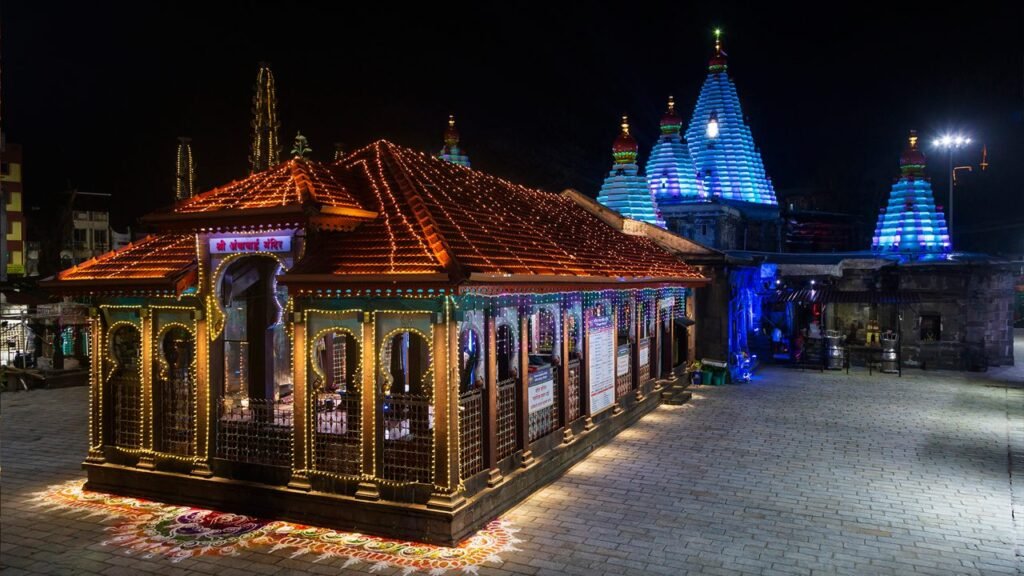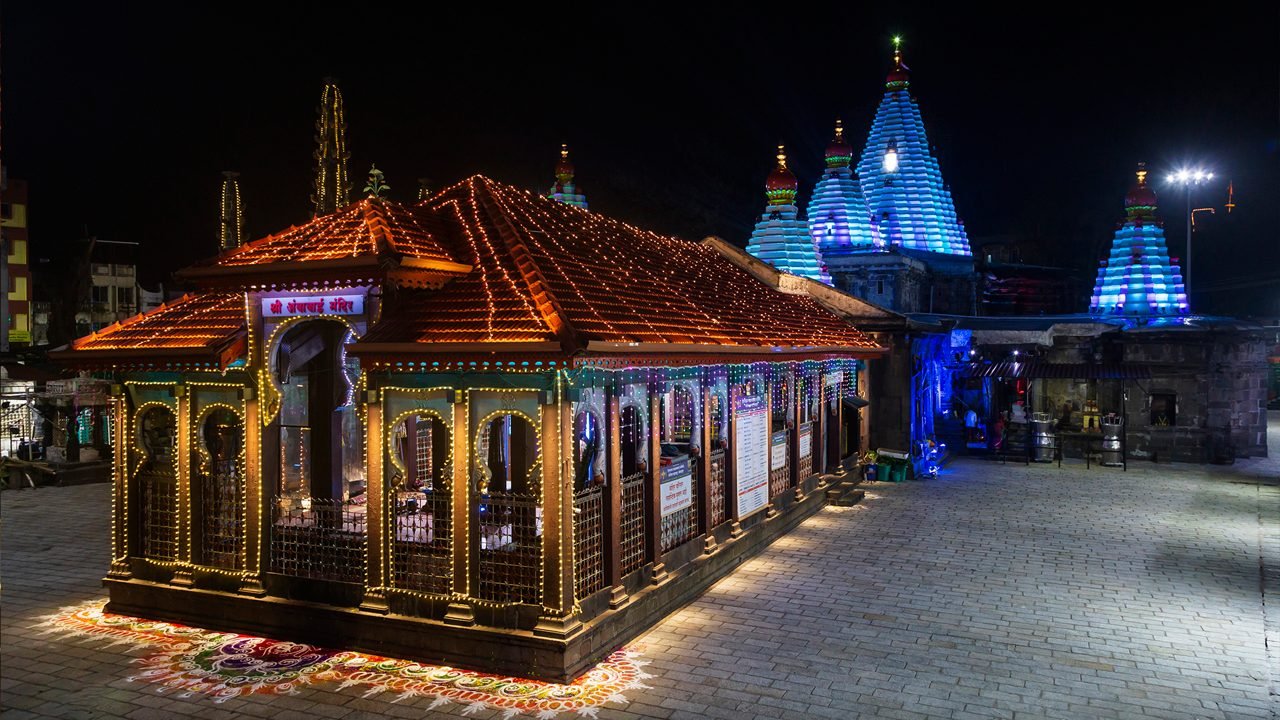The Mahalaxmi Temple in Kolhapur, Maharashtra, is not just a place of worship—it’s the heart of devotion, tradition, and divine energy in southern Maharashtra. Revered as Ambabai, the goddess Mahalaxmi is considered the divine mother who protects her devotees and blesses them with prosperity and peace.
In this blog, we explore the historical roots, architectural grandeur, spiritual aura, and cultural importance of Mahalaxmi of Kolhapur, one of the Shakti Peethas of India and a site that draws millions of devotees each year.

https://www.incredibleindia.gov.in/en/maharashtra/kolhapur/mahalaxmi-temple
🕉️ Mythological and Spiritual Significance
The Mahalaxmi Temple is one of the 18 Maha Shakti Peethas mentioned in the ancient Hindu scriptures like the Devi Purana. According to legend, the face or eyes of Sati (Parvati) fell here after her body was dismembered by Lord Vishnu using the Sudarshan Chakra to calm Lord Shiva’s rage. Each Shakti Peeth represents a body part of the goddess, and Kolhapur holds immense power due to this sacred connection.
The goddess here is worshipped as Mahalaxmi, the consort of Lord Vishnu, symbolizing wealth, strength, and courage. It’s also believed that Lord Vishnu resides in Tirupati while Mahalaxmi resides in Kolhapur, and devotees often visit both temples to complete their spiritual journey.
🏛️ History and Architecture
The temple dates back to the 7th century, during the reign of the Chalukya dynasty, and later flourished under the Shilahara and Yadava rulers. It has survived invasions, renovations, and restorations over the centuries, maintaining its original spiritual charm.
🧱 Key Architectural Features:
- The temple is built in Hemadpanthi style using black basalt stone.
- The main idol of Mahalaxmi is made of black stone, approximately 3 feet tall, with four arms holding a mace, shield, panpatra (bowl), and a fruit.
- The crown (karanda mukut) on her head is adorned with precious stones.
- The temple complex houses smaller shrines dedicated to Mahakali, Mahasaraswati, Ganapati, and Vishnu.
- Intricately carved pillars, toranas (arches), and mandapas (halls) enhance the sacred ambiance.
🌅 The Marvel of Kiranotsav (Sun Festival)
One of the most unique and scientifically aligned phenomena associated with the Mahalaxmi Temple of Kolhapur is the Kiranotsav. On certain days in January, February, and November, the sun’s rays directly fall on the idol of the goddess:
- First day: Rays fall on the feet
- Second day: Rays fall on the chest
- Third day: Rays fall on the face
This celestial alignment showcases the advanced astronomical knowledge of ancient Indian architects and adds a divine glow to the spiritual experience.
🎉 Major Festivals Celebrated
1. Navratri Festival
Navratri is celebrated with grandeur at the temple. Thousands of devotees come to seek blessings from Ambabai. The idol is beautifully decorated, and the temple is lit up with lamps and flowers.
2. Kiranotsav
As explained earlier, this unique celebration draws crowds from across India who witness the miracle of solar alignment.
3. Kartik Utsav
This marks a series of spiritual rituals, kirtans, and religious gatherings in the month of Kartik (October-November).
4. Chaitra Utsav
Held in the Hindu month of Chaitra, this celebration is rich with music, religious discourses, and temple processions.
5. Margashirsha Utsav
In the holy month of Margashirsha, women especially come in large numbers to perform special pujas and participate in religious activities.
🛣️ How to Reach Mahalaxmi Temple, Kolhapur
- By Road: Well-connected by state transport buses and private vehicles from major cities like Pune, Mumbai, and Goa.
- By Train: Kolhapur Railway Station (Shahu Maharaj Terminus) is 5 km from the temple.
- By Air: The nearest airport is Kolhapur Airport (Ujalaiwadi), approx. 10 km away.
🏨 Where to Stay in Kolhapur
Kolhapur is a tourist-friendly city with plenty of budget hotels, dharmashalas, and mid-range to luxury hotels near the temple. Some temples also offer free or affordable stay options for pilgrims.
🍛 Local Experiences and Culture
Visiting Mahalaxmi is also an invitation to explore Kolhapur’s rich heritage, including:
- Kolhapuri Chappals: Handcrafted leather sandals with global fame
- Kolhapuri Misal: A spicy, flavorful local delicacy
- Kolhapuri Saaj: Traditional Maharashtrian jewelry, often worn by brides
- Rankala Lake & New Palace Museum: Tourist attractions close to the temple
The temple isn’t just a religious site—it’s a cultural nucleus of Kolhapur.
🌺 Rituals & Darshan Timings
- Morning Kakad Aarti: 4:30 AM – 6:00 AM
- Abhishek & Mahapooja: 6:00 AM – 8:00 AM
- Alankar & Naivedya: 8:00 AM – 12:00 PM
- Afternoon Pooja: 12:00 PM – 4:00 PM
- Evening Aarti & Darshan: 4:00 PM – 10:00 PM
Note: Special darshan passes are available during Navratri and other festivals.
🧎♀️ Devotees’ Belief and Cultural Relevance
For millions of devotees, Ambabai is a mother figure who listens to every prayer. Many visit to seek blessings for:
- Marriage
- Career success
- Good health
- Protection from evil
- Fulfillment of vows
Local folklore and bhajans often refer to Ambabai as the “Kshitijatil Karveer Nivasini” – the divine queen of Karveer (old name for Kolhapur).
📜 Temple Trust and Management
The temple is currently managed by the Kolhapur Devasthan Management Committee, which oversees daily rituals, temple maintenance, and festivals. It also runs schools, dharmashalas, and community welfare activities.
💬 Famous Quotes & Devotional References
“Ambabai is not just a deity; she is the heart of Kolhapur.”
“No journey in Maharashtra is complete without darshan of Mahalaxmi.”
🧳 Final Words: A Must-Visit Pilgrimage
Whether you’re spiritually inclined or a seeker of heritage, the Mahalaxmi Temple of Kolhapur offers a powerful blend of devotion, ancient architecture, culture, and tradition. The peaceful yet divine aura, the temple bells, and the sight of Ambabai in all her glory leave a lasting impression on every visitor.
🔑 Recap: Why Visit Mahalaxmi of Kolhapur?
- One of the most important Shakti Peethas in India
- Scientifically designed Kiranotsav solar marvel
- Rich Chalukya-era architecture
- Powerful spiritual and cultural energy
- Ideal for both pilgrims and heritage tourists


